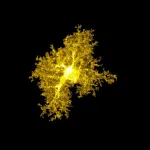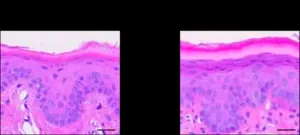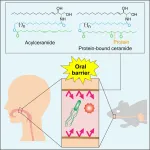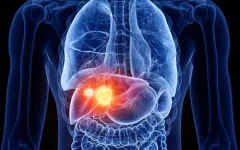(Press-News.org) A type of cell usually characterized as the brain’s support system appears to play an important role in obsessive-compulsive disorder-related behaviors, according to new UCLA Health research published April 12 in Nature.
The new clue about the brain mechanisms behind OCD, a disorder that is incompletely understood, came as a surprise to researchers. They originally sought to study how neurons interact with star-shaped “helper” cells known as astrocytes, which are known to provide support and protection to neurons.
However, scientists are still trying to understand the apparent role these complex cells play in psychiatric and neurodegenerative diseases.
By studying the proteins expressed by neurons and astrocytes in mice, UCLA researchers found a protein associated with OCD and repetitive behaviors in neurons was also found in astrocytes. The discovery suggests therapeutic strategies targeting astrocytes and neurons may be useful for OCD and potentially other brain disorders.
“Our research has revealed a new cellular mechanism, which not only involves neurons – something we already knew – but also involves astrocytes, working together,” said corresponding author Baljit Khakh, a professor of physiology and neurobiology at the David Geffen School of Medicine at UCLA. “Now we could expand our research in this area to cover additional mechanisms and cells.”
OCD, a lifelong anxiety disorder characterized by repetitive thoughts and actions, affects an estimated 2-3% of the U.S. population in their lifetimes, though its prevalence may be higher due to underreporting and underdiagnosis. Psychotherapy, antidepressant medication, or both are typically prescribed for OCD, but available treatment is ineffective for a sizable share of patients.
A brain region known as the striatum, which is involved in decision-making and motor control, is thought to play a key role in OCD. That is exactly the area of the brain the UCLA researchers studied when they sought to examine the interactions between astrocytes and neurons.
Khakh is among the researchers in recent years who have extensively studied astrocytes, thanks to technological advances that have made it more feasible to study these complex cells. While previous research has compared gene expression between neurons and astrocytes, this new study advanced our understanding of the interplay between the two cell types by analyzing protein expression.
“We really have to look at the proteins because they are very complex and diverse,” said co-author Joselyn Soto, a neuroscience PhD student at UCLA’s medical school. “Depending on which cell expresses which proteins, we can predict the functions of that cell.”
The researchers used multiple approaches to isolate and visualize proteins across neurons and astrocytes within the striatum. When they compared proteins found in neurons and astrocytes, they unexpectedly discovered both contained a protein associated with OCD known as SAPAP3.
The researchers tested their findings by inserting the SAPAP3 protein back into neurons and astrocytes of mice that had been genetically modified to lack the gene that makes the protein. They found that the two types of cells interacted in different ways when they measured the protein’s effects on compulsion and anxiety, two of the typical hallmarks of OCD.
The mice no longer compulsively groomed themselves after the SAPAP3 protein was delivered back to astrocytes and neurons, suggesting that both types of cells could be valid targets for treatments aimed at curbing compulsion. However, only neurons with the SAPAP3 protein were associated with reduced anxiety in the mice, suggesting that astrocytes would not be a good target for anxiety treatments in OCD.
Soto said future research would delve deeper into how the interactions between these cells affect behavior.
“These are both major cell types – one doesn’t work without the other,” Soto said. “We really wanted to understand how these multicellular interactions within this brain region give rise to these complex behaviors, including compulsion and anxiety.”
Adding that there needs to be more work to even understand how astrocytes are formed and maintained, Khakh said this new study’s unexpected findings demonstrated the value of pursuing basic biology questions to help form new ideas about the basis of diseases.
“This started from a basic question: What proteins make up this complex cell?” he said. “At the outset, we couldn’t have predicted its potential relevance to OCD.”
Other authors include Yasaman Jami-Alahmadi, Jakelyn Chacon, Stefanie L. Moye, Blanca Diaz-Castro, and James A. Wohlschlegel, all of UCLA.
END
The brain’s support cells may play a key role in OCD
An effort to map complex and understudied cells leads to a surprise discovery
2023-04-12
ELSE PRESS RELEASES FROM THIS DATE:
Pragmatica-Lung Study, a streamlined model for future cancer clinical trials, begins enrolling patients
2023-04-12
The National Cancer Institute, part of the National Institutes of Health (NIH), has helped launch a phase 3 randomized clinical trial (NCT05633602) of a two-drug combination to treat patients with advanced non-small cell lung cancer (NSCLC). Called the Pragmatica-Lung Study (or S2302), this is one of the first NCI-supported clinical trials to use a trial design that removes many of the barriers that prevent people from joining clinical trials. This “pragmatic” approach aims to increase accessibility ...
Oral barrier is similar in ceramide composition to skin barrier
2023-04-12
Acylceramides and protein-bound ceramides are vital for the formation of the oral barrier in mice, similar to their role in skin, protecting from infection.
The skin is the body’s first line of defense against the environment, particularly against pathogens, chemicals, and allergens. It is now known that a class of biological molecules called acylceramides and their metabolites, protein-bound ceramides, are essential to the formation of this barrier. The outermost tissues of the mouth are closely related to the skin and have similar functions—an oral barrier. However, little ...
How did Earth get its water?
2023-04-12
Washington, DC—Our planet’s water could have originated from interactions between the hydrogen-rich atmospheres and magma oceans of the planetary embryos that comprised Earth’s formative years, according to new work from Carnegie Science’s Anat Shahar and UCLA’s Edward Young and Hilke Schlichting. Their findings, which could explain the origins of Earth’s signature features, are published in Nature.
For decades, what researchers knew about planet formation was based ...
Effect of smartphone app home monitoring after oncologic surgery on quality of recovery
2023-04-12
About The Study: In this randomized clinical trial, postoperative follow-up for patients undergoing breast reconstruction and gynecologic oncology surgery using smartphone app–assisted monitoring led to improved quality of recovery and equal satisfaction with care compared with conventional in-person follow-up.
Authors: Claire Temple-Oberle, M.D., M.Sc., of the University of Calgary in Calgary, Alberta, Canada, is the corresponding author.
To access the embargoed study: Visit our For The Media website at this link https://media.jamanetwork.com/
(doi:10.1001/jamasurg.2023.0616)
Editor’s ...
Taking a placebo improves adherence to treatment for opioid use disorder, study finds
2023-04-12
Substance use disorder affects 20 million Americans, and more than 100,000 people died from a drug overdose in 2021, according to the Centers for Disease Control and Prevention. While the medication methadone has the strongest evidence-based effectiveness to prevent relapse, about half of patients drop out of their treatment within one year of initiation. The solution could lie in taking a simple “sugar pill” or placebo along with the methadone, according to a randomized clinical trial led by researchers at the University of Maryland School of Medicine.
In a randomized ...
New study flips the script on liver cancer
2023-04-12
Liver cancer is the third leading cause of cancer death and the sixth most common cancer type worldwide. Major risk factors include environmental and metabolic stressors, such as obesity, viral hepatitis and steatohepatitis (fatty and inflamed liver).
These stressors damage the liver by killing hepatocytes, the major cell type in the liver. The cell death then triggers an inflammatory response which signals the liver to generate a new batch of hepatocytes. But this sudden push towards cellular proliferation also increases the risk of tumor formation.
In ...
SWOG S2302 Pragmatica-Lung study opens to enrollment, a model for easier, more representative clinical trials
2023-04-12
A clinical trial that breaks new ground with its dramatically streamlined design and unusually broad eligibility criteria is now opening and available to patients with stage 4 or recurrent non-small cell lung cancer at cancer treatment clinics all across the United States.
The S2302 Pragmatica-Lung trial, developed and led by the SWOG Cancer Research Network, a clinical trials group funded by the National Cancer Institute (NCI), is designed to be easier for institutions to open and run and with few limits on eligibility, making it available to a larger group of patients with advanced non-small cell lung ...
Researchers reveal stability origin of Dion-Jacobson 2D perovskites
2023-04-12
Yin-Yang theory is an ancient Chinese philosophy in which Yin-Yang forces are interdependent and work in opposition to each other to create balance.
Recently, inspired by this ancient theory, a research team led by Prof. GUO Xin and Prof. LI Can from the Dalian Institute of Chemical Physics (DICP) of the Chinese Academy of Sciences (CAS) has revealed the origin of the stability of Dion–Jacobson (DJ) phase two-dimensional (2D) perovskite materials.
Their findings were published in Joule on April 12.
DJ 2D perovskites, a class of organic–inorganic ...
Scientists track evolution of microbes on the skin’s surface
2023-04-12
CAMBRIDGE, MA -- Human skin is home to millions of microbes. One of these microbes, Staphylococcus aureus, is an opportunistic pathogen that can invade patches of skin affected by eczema, also known as atopic dermatitis.
In a new study, researchers at MIT and other institutions have discovered that this microbe can rapidly evolve within a single person’s microbiome. They found that in people with eczema, S. aureus tends to evolve to a variant with a mutation in a specific gene that helps it grow faster on the skin.
This study marks ...
NCCN Annual Conference brings up important questions for improving cancer care
2023-04-12
PLYMOUTH MEETING, PA [April 12, 2023] — The NCCN 2023 Annual Conference took place in-person in Orlando and virtually, with a particular focus on human connection. That connection was underscored with more than 2,000 registrants from across the continuum of cancer care, including approximately 1,000 who returned in-person for the first time since 2019. Educational sessions highlighted the importance of ensuring care meets the latest standards while also rejecting a one-size-fits-all approach.
“At NCCN, we don’t shy away from difficult discussions; we want our conference attendees to take away the message that ...
LAST 30 PRESS RELEASES:
Sleeping in on weekends may help boost teens’ mental health
Study: Teens use cellphones for an hour a day at school
After more than two years of war, Palestinian children are hungry, denied education and “like the living dead”
The untold story of life with Prader-Willi syndrome - according to the siblings who live it
How the parasite that ‘gave up sex’ found more hosts – and why its victory won’t last
When is it time to jump? The boiling frog problem of AI use in physics education
Twitter data reveals partisan divide in understanding why pollen season's getting worse
AI is quick but risky for updating old software
Revolutionizing biosecurity: new multi-omics framework to transform invasive species management
From ancient herb to modern medicine: new review unveils the multi-targeted healing potential of Borago officinalis
Building a global scientific community: Biological Diversity Journal announces dual recruitment of Editorial Board and Youth Editorial Board members
Microbes that break down antibiotics help protect ecosystems under drug pollution
Smart biochar that remembers pollutants offers a new way to clean water and recycle biomass
Rice genes matter more than domestication in shaping plant microbiomes
Ticking time bomb: Some farmers report as many as 70 tick encounters over a 6-month period
Turning garden and crop waste into plastics
Scientists discover ‘platypus galaxies’ in the early universe
Seeing thyroid cancer in a new light: when AI meets label-free imaging in the operating room
Neutrophil-to-lymphocyte ratio may aid risk stratification in depressive disorder
2026 Seismological Society of America Annual Meeting
AI-powered ECG analysis offers promising path for early detection of chronic obstructive pulmonary disease, says Mount Sinai researchers
GIMM uncovers flaws in lab-grown heart cells and paves the way for improved treatments
Cracking the evolutionary code of sleep
Medications could help the aging brain cope with surgery, memory impairment
Back pain linked to worse sleep years later in men over 65, according to study
CDC urges ‘shared decision-making’ on some childhood vaccines; many unclear about what that means
New research finds that an ‘equal treatment’ approach to economic opportunity advertising can backfire
Researchers create shape-shifting, self-navigating microparticles
Science army mobilizes to map US soil microbiome
Researchers develop new tools to turn grain crops into biosensors
[Press-News.org] The brain’s support cells may play a key role in OCDAn effort to map complex and understudied cells leads to a surprise discovery





